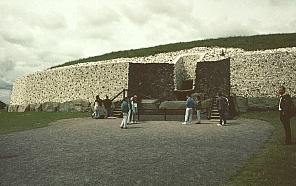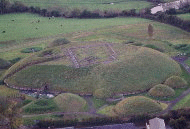The Newgrange passage tomb
was built 5,000 years ago and regarded
as the world'sfirst solar observatory.At
the winter solstice on 21 December, the rays of the sun shine directly
 down
the passageway; during tours, the effect is recreated by electric light.
down
the passageway; during tours, the effect is recreated by electric light.
The Boyne Valley Mounds at Newgrange, Knowth and Dowth were built around 3200BC making them older than Stonehenge in England and the Pyramids of Giza in Egypt. There is a lively debate about whether these wonderful Megalithic Monuments were built primarily as Burial Tombs, Sacred Temples or Astrological Observatories. While Passage Tomb is the traditional description for Newgrange and similar Monuments, Chambered Cairn or Passage Cairn are the descriptions favoured by those who consider the Passage Tomb description too narrow. The large stones surrounding and inside the Passage Tombs are decorated with Megalithic Art such as spirals, concentric circles, triangles, zigzags and images which have been interpreted as the sun, moon and the human face.
Irish Passage Tombs tend to occur in clusters traditionally
described as a Necropolis or Cemetery. The Boyne cluster includes Newgrange, Knowth and Dowth. The other great
cluster in County Meath are on the hills around Loughcrew. The Boyne
Valley Cairns of Newgrange, Knowth and Dowth have been designated World
Heritage Sites by UNESCO and attract 200,000 visitors per year. The
sites and Visitor Centre are managed by Dúchas the Irish Heritage
Service. Newgrange is best known for the illumination of its passage
and chamber by the winter solstice sun. The site is open to the public
with controlled access to the passage and chamber. Tours of Newgrange
start at the Brú na Bóinne Visitor Centre located near
the village of Donore, Co. Meath.
The Boyne cluster includes Newgrange, Knowth and Dowth. The other great
cluster in County Meath are on the hills around Loughcrew. The Boyne
Valley Cairns of Newgrange, Knowth and Dowth have been designated World
Heritage Sites by UNESCO and attract 200,000 visitors per year. The
sites and Visitor Centre are managed by Dúchas the Irish Heritage
Service. Newgrange is best known for the illumination of its passage
and chamber by the winter solstice sun. The site is open to the public
with controlled access to the passage and chamber. Tours of Newgrange
start at the Brú na Bóinne Visitor Centre located near
the village of Donore, Co. Meath.
The great mound of Knowth, nearby, dates from about 2000
BC to 2500 BC, has two passage tombs and 17 satellite tombs.  Knowth
also has the greatest collection of passage tomb art ever discovered
in Europe. Knowth has two passages and is surrounded by seventeen satellite
cairns. The site is open to the public; however there is no public access
to the interior passages and chambers. Tours of Knowth also start at
the Brú na Bóinne Visitor Centre. Dowth is the only one
of the three large Brú na Bóinne Passage Tombs which is
not accessible from the Visitor Centre situated on the south bank of
the river.
Knowth
also has the greatest collection of passage tomb art ever discovered
in Europe. Knowth has two passages and is surrounded by seventeen satellite
cairns. The site is open to the public; however there is no public access
to the interior passages and chambers. Tours of Knowth also start at
the Brú na Bóinne Visitor Centre. Dowth is the only one
of the three large Brú na Bóinne Passage Tombs which is
not accessible from the Visitor Centre situated on the south bank of
the river.
Visitors to Dowth must drive directly to the site on the north bank, a couple of miles from the Slane / Drogheda road. Fourknocks with its short passage leading into a wide pear shaped chamber is in similar style to Tombs in Portugal. Just inside the main chamber to the left of the entrance is one of the few representations of a human face from the Neolithic Period in Ireland.
Loughcrew Cairns form the largest complex of Megalithic structures in Ireland. The Cairns contain symbolic engravings similar in style to Newgrange. Like other Passage Tombs in Ireland, they have clear astrological alignments.
Also in this immediate area, it's worth seeing the collection of old farm machinery, the cooper's workshop and the blacksmith's forge at Oengus Lodge. 11 km (7 miles) W of Drogheda.
Newgrange: Admission charge. Tel. (041) 24488.
Knowth: Admission charge.
Oengus Lodge: Admission charge. Tel. (041) 24150.
An excerpt from Irish Museums and Heritage Centres.
